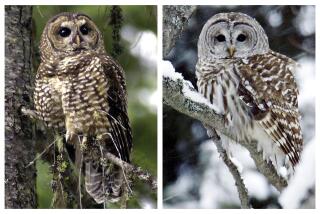Reduction Is Sought in Use of Lead Shot
- Share via
After studying the subject for four years, the U.S. Fish and Wildlife Service is expected to initiate moves later this month to reduce the amount of lead shot used by waterfowl hunters.
Observers expect the service to propose a ban on lead shot in waterfowl hunting areas where bald eagles and other birds of prey are subject to lead poisoning by eating waterfowl afflicted with lead poisoning.
According to the Audubon Society, 2 to 3 million ducks and geese die every year after eating spent lead shot from the bottoms of marshes. One study shows lead poisoning as the No. 4 cause of death for bald eagles.
Some states have taken the lead in requiring steel shot and banning lead shot. Nebraska has approved a statewide ban on lead shot. Similar bans are proposed in Iowa, New Jersey, Kansas and New Mexico.
The Department of Fish and Game reminds waterfowl hunters that the duck season ends Jan. 17 on the Colorado River, and Sunday in the rest of the state. Goose hunting ends Sunday in northeast California, Jan. 20 in the rest of the state.
Everett E. Horn, one-time project coordinator of the state Wildlife Conservation Board and a pioneer biologist for the U.S. Fish and Wildlife Service, died in Palo Alto recently at 88. He was once president of the California Conservation Council.
Briefly Recent severe winters in northern Utah have depressed populations of chukar partridges, causing the state’s Department of Wildlife to begin raising chukar at a state game farm. . . . Bob Quigley, master at fly tying, will speak to the San Gabriel Valley Fly Fishers at their meeting Jan. 23 at the Whittier Narrows Recreation Center, El Monte. . . . More than 1,000 new boats are expected to be displayed at the Los Angeles Boat Show at the Los Angeles Convention Center Feb. 1-10.
More to Read
Sign up for Essential California
The most important California stories and recommendations in your inbox every morning.
You may occasionally receive promotional content from the Los Angeles Times.













